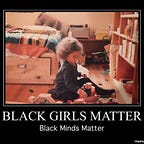Hidden Figures is a Black, not white, Women’s Story
It’s important to know the difference between “marginalized” and “hidden”
These remarks were made in my role as respondent to a paper on the (white) women students of (white woman) astronomer Maria Mitchell at the 2017 Society of History of Technology meeting. They were well received by the person whose work I was commentating on.
I will respond by offering a history of my own knowledge of women in astronomy. My interest in the Hidden Figures has been strongly shaped by my own experiences as a Black woman working at the intersection of physics and astrophysics. As an undergraduate at Harvard in the early 2000s, I was aware of the white women who had acted as computers for the Harvard College Observatory — this was history that astronomy undergraduates were privy to and that someone (I don’t remember who) took some effort to ensure that at the least women undergraduates learned about. The idea that their history or role was hidden, for this reason, has always seemed jarring to me. They were not hidden to us even as we recognized that more broadly they were a site of disinterest for many, but it was always made clear to me as an undergraduate that while their opportunities were limited, white women astronomers had been part of early American astronomy and that they had played a significant role in my own sub field, cosmology. (As in, without Harvard Computer Henrietta Leavitt’s discovery of the cepheid variable luminosity relation, Hubble could not have discovered the expansion of the universe. Of course, I didn’t learn until much later that Leavitt was a deaf adult, and it is interesting what parts of her story were left out.)
By contrast, I know that when Duchess Harris and Margot Lee Shetterly sought funding for their research on the Black women of NASA that they were disbelieved by funders that such women had ever existed. It was only by producing a 1967 “thank you for your 20 years of service” note on NASA letterhead to Duchess’s grandmother — one of the women who would later appear on the cover of Shetterley’s book — that the funder came to believe this wasn’t a tall tale.
Simultaneously, I learned about the Hidden Figures right around the time that they were at work in the archives. Nichelle Gainer, the author of Vintage Black Glamour, had found an archived picture of Melba Roy, one of the Black women scientists at NASA and posted it to her tumblr. It was there that I first learned that women like Roy existed, two years after I earned my PhD in 2011, and not long after I had left my first postdoctoral fellowship at NASA.
My training as a theoretical physicist or astrophysicist — depending on who you ask — had not hidden white women in astronomy from me so much as been disinterested in them, but in the case of Black women in astronomy, their existence was literally unbelievable, so unbelievable that it was not considered reasonable to go looking for them. And then, even after a text about them was published and a film made about them, I still found myself arguing with white women colleagues about whether I was allowed to call Black women who worked on space science at the National Aeronautics and Space Administration “astronomers.”
The reason I tell these stories and introduce this personal narrative is to offer the provocation of asking what do we mean when we talk about “Hidden Figures,” and to ask what it means when we adapt a language specifically generated to describe Black women’s experiences to women who are not Black. What is the intersectional analysis at play or not at play in a discourse that adapts this terminology away from the Black experience? So my first question would be, “Were Maria Mitchell’s students truly hidden or rather considered unworthy of study?” Either scenario is of course problematic, but what is lost — for both stories — when we treat the two situations as comparable historiographic failures? What other situations might we view as discursively distinct or discursively related? In what ways do we reproduce the hiddenness of hidden figures by looking more carefully at people we know are there while not looking for people we might imagine should be there? (Perhaps a salient example would be: Native American women in a variety of scientific contexts?) In relation, how do we search for that which is unimaginable but potentially incredibly real? Are there ways in which Black women in the mathematical and astrophysical sciences continue to be hidden, even in broad day light? Is there a distinction between a hidden figure and a marginal figure? If not, why?
